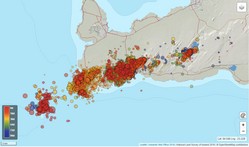More research is needed to decipher the on-going activity at the Reykjanes Peninsula as a whole
From the beginning of 2020, over 6000 earthquakes have been manually checked on the Reykjanes peninsula.
On Thursday the 26th of March an on-line Scientific Advisory Board meeting was held to discuss the ongoing unrest in the Reykjanes peninsula. Scientists from IMO, University of Iceland, ISOR and representatives from Civil Protection, HS-Orka, ISAVIA-ANS, and the Environment Agency of Iceland attended the meeting.
Magmatic intrusion still the most likely explanation for the ongoing earthquake activity north of Grindavík
Recent data show that uplift has started again, with the center just west of Mt. Thorbjorn. Uplift was measured from 22. January 2020 until beginning of February and has started up again during the first half of March. During the first sequence in January-February, the deformation rate was about 3-4 mm per day with a total of a 6 cm uplift during the whole period. In the sequence that is ongoing now, the deformation rate looks to be only half of what it was (or even slower). In total the uplift is about 7-8 cm since the end of January. The Scientific Advisory Board still believes that the most likely explanation of the uplift is a magma intrusion where the magma is “forcing” its way horizontally between the stratum in the crust and forming a thin sill at about 3 to 4 km depth. The magma intrusion causes considerable amount of earthquakes in the area north of Grindavík.
The people of Grindavík have not missed out on the earthquake activity. On the 19th of March, a shallow earthquake swarm was measured in the vicinity to an injection borehole in Svartsengi, only 3 km north the edge of the town. A model of the ongoing magma intrusion shows that fissures can open in the uppermost layer of the crust, at 1-2 km, because of the tensional stress induced by the uplift itself. This change in the crustal stress might lead to more earthquakes related to injection at boreholes, which was not common before in the area. The work procedure for the injections will be reviewed in collaboration with HS-Orka and discussion will be taken on how is the best way to monitor the earthquakes likely due to these changes.
It is important to monitor and investigate the ongoing activity in the Reykjanes peninsula as a whole.
During the meeting it was reported that from the beginning of 2020, over 6000 earthquakes have been manually checked in the Reykjanes peninsula. This is the most intense activity ever recorded in the region since the beginning of digital monitoring in 1991. On Saturday the 28th of March, and earthquake swarm occurred in Eldey, indicating that the activity is affecting all volcanic systems in the peninsula and the ridge, i.e from Eldey all the way to Krýsuvík. The interpretation of these events is still uncertain, but there are indications that a common underlying process is the cause of the activation of such a widespread area in such a short timeframe. However, the Reykjanes peninsula and the Reykjanes ridge are composed of plate boundaries were also, the Eldey, Reykjanes, Svartsengi and Krýsuvík volcanic systems lie right across the boundaries. Because of the activity ongoing in the area, the SAB believes that it is extremely important to monitor and investigate the ongoing activity in the Reykjanes peninsula as a whole, and compare this activity with older events in the area to try to decipher the reasons and identify possible developments.
The SAB would like to emphasize that the possible scenarios which were discussed in the endof January are still in force.
The SAB will meet again on the 8th of April, if no changes will occur.




